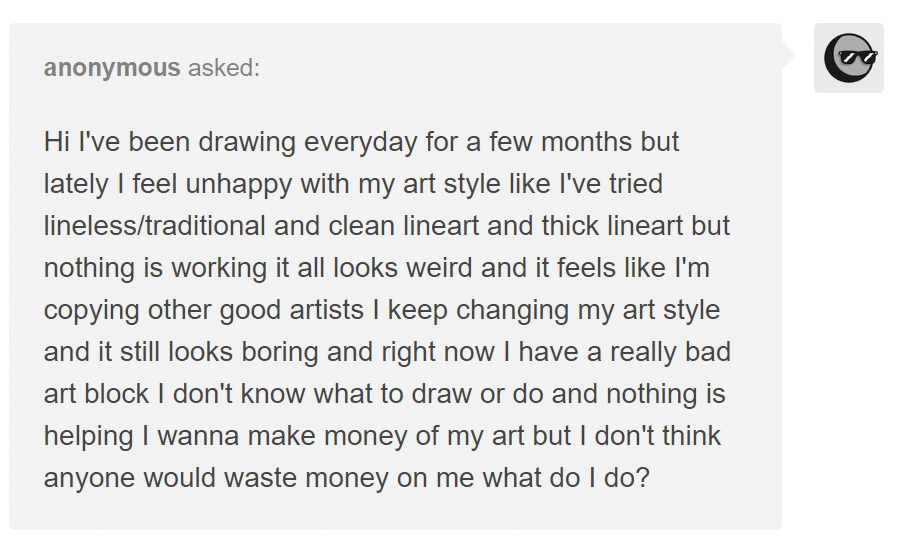


I think, of all the questions i have personally recieved and seen being thrown around the art community both IRL and the internet, ‘style’ is one of the things that come up most frequently. Especially with young and budding artists who are looking to find their identity and foothold within the field. it’s a valid topic too. The style is your first calling card. it’s your first-hand impression with your audience, and the first thing people will notice about your art. So it’s worth putting effort into making sure you communicate what you want through it. Whether that be by subscribing to already popular styles, such as one of the many types of manga/anime styles, western comic, realism - or by concocting something up that is unique to you.
Mostly i hear people wanting to develop their very own, distinct visual identity through their stylization. So i ‘ll be talking about that very specific journey through in this little essay.
First thing about art style..
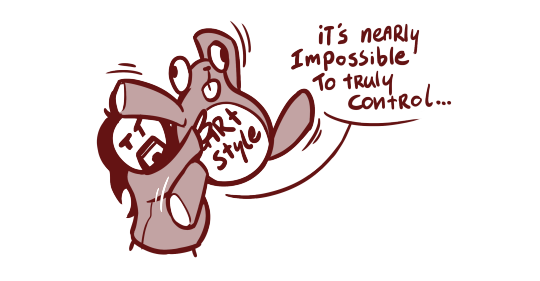
It is true that some artists have mastered the ability to mimic other styles, or have a firm hold on how to veer their native style as they please. These people are highly trained, highly skillfull - and have probably poured years and years into learning how to “control” their visual identity effectively.
For the rest of us learning lot, outright “controlling” our art-style is a bit more of a finnicky progress. Like hauling an unruly creature around with its limbs flailing everywhere. It’s heavy, it’s slow, it’s pretty frustrating and chaotic.
And the best thing we can do:
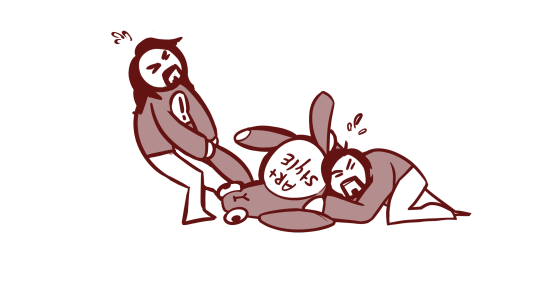
Is to try to wrangle it in whichever direction we want it to go.
But why is it so hard?..
Because a majority of your art style comes from your subconscious.
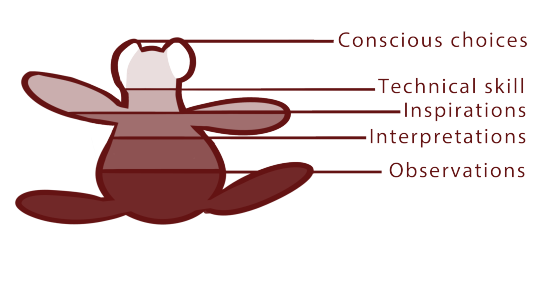
It might not come as a surprise to many. But your subconscious makes a lot of choices for you when you draw. And it is true - that you can make conscious choices about your style too. But unless you have extensive training in swaying your subconscious mind - the changes your conscious mind will implement to your native style is going to be mostly superficial.
So what’s your art-style made up of exactly?:
Let’s say you’re looking at a person from across the street, you want to draw this person.
From the moment you catch a glimpse of the subject ( in this case, the person ) of your drawing ( or try imagine one up ) - your brain goes on a long journey through a couple of stages that ultimately shape how you’ll stylize this particular person on paper.
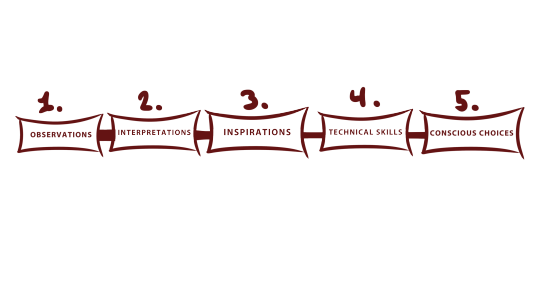
Observations What information your brain derives from looking at people/objects/environments
InterpretationsHow your brain interprets this information
InspirationsWhat subconscious inspirations affects this interpretation
Technical SkillHow accurately can your hand reproduce this information.
Conscious choicesWhat conscious choices do you make when reproducing the information visually.
Observations + Interpretations
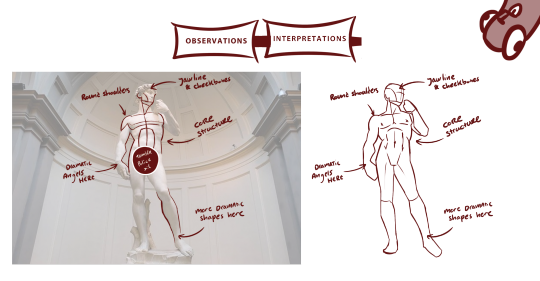
From the very moment you see the person, your brain is already picking and chosing which parts to focus on. If you’re usually the type to be fascinated with sihlouette, you might pick up on how their jacket juts out from their shoulders, making them look very wide. Or how the hair sits around their head.If you’re very detail oriented, you might notice little wrinkles under their eyes or that sort of more minute features.
These focal points will be what you’ll ultimately end up focusing on in your style.
Interpretations
Now your brain has taken in all these details, shapes and volumes of a person and its time to translate that into raw input for your imagination. How you interpret this information all comes down to the individual person. Above, i’ve made note of some of the details that my brain registered among the first things. And to me, working as a comic/semi-realistic artist, my brain immediately breaks these observations down into planes and lines. If you’re a painter, it is likely that your brain will break the information down into 3 dimensional volumes. If you’re an abstract artist, it’s likely that you’ll interpret this information moreso in simple shapes.
Not one way is the correct one, since your way of interpreting is completely tuned to how you work naturally as an artist.
How to change this:
These two aspects are probably the most difficult to change since it is so deeply rooted in your individual artistic preference and journey. Though, there are excersizes that can help you see and process information in a new way. Such as drawing a familiar object with mediums vastly different from your own. ( if you work primarily in digital mediums, that could be working with analogue inks or coal ). These switches will push you out of your comfortzone, and force you to process information differently in order to capture the subject of your drawing as “accurately” as possible with the foreign medium.
Inspirations
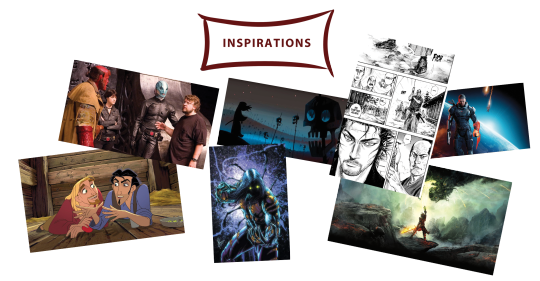
It’s no secret that we take great inspiration from the things around us. Including media, art, stories, you name it. Whether intentional or not, when we are exposed to something interesting, ( especially if on a repeating basis ) we will begin to incoporate it in our art. It’s a passive influencer that, while frustrating in keeping us locked in perpetual cycles of the same visuals ( say, if one tends to consume visual input through mostly one style ) - can be one of the greatest benefactors of a unique and continously developping style and visual identity.
Once your brain has taken information in, and told our subconscious how that should look on paper ( or sometimes during the phase of interpretation ), it draws on these specific stylistic references, and tells you and your hand how your recreation of the subject could potentially look.
How to change this:
Unlike how we process information, influencing our inspirational sources is one of the simpler things we can do to move our art-style along. Naturally, you’ll always have the influences of your old inspirations in your style somewhere. It’s nothing to be worried about, it adds flavor to how your style looks and reflects on who you are as an artist. However, if you want to move towards a style a little different from what your inspirational sources look like - it’s time to implement that particular style into your regular digest of media, as well as making an effort of studying these styles and their internal logic.
Technical skill

How polished and how adept you are at recreating the information on paper through the application of technical skills ( anatomy, construction, perspective, composition, colouring, etc ) will have a great influence on how your style looks. Whether we like it or not, our native style will center around framing our strengths - and obscuring our weaknesses.
So if you have a style that doesn’t do much in noses, then it could mean that working on your facial anatomy could benefit the progression of your style.
Most of the time, our technical skills are one of the major limitators on how freely we can veer our style in whichever way.
How to change this:
I would be lying if i said that you could just keep practicing art fundamentals - and see your style change dramatically in the exact direction you want.
But by continuing to practice these fundamentals, you will continue to push your limitations, so that you will have less technical limitation when wanting to alter your art-style.
Conscious choices
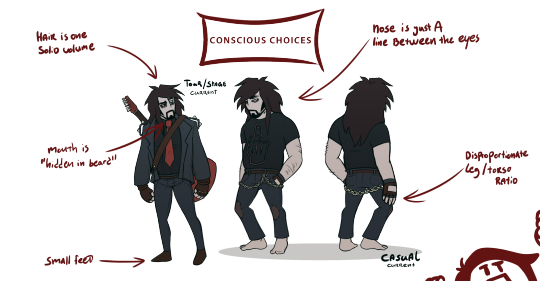
Although of course, making an effort to switch things up in the other stages, this is the part where you can make a conscious and quickest effort. In picking and chosing between features that you enhance, leave out, minimize or abstract.
The image above is not one of my native styles, but a more toony one that i’ve acquired alongside my semi-realism over the years. In this style, i’ve completely scrapped my otherwise very recognizeable noses and mouths. I’ve changed my usual proportions up, and toned back the detail level, trading it instead for a heavy focus on sihlouette and shape.
These are all conscious choices that i’ve made in the moment of designing the character in order to really distinguish him from my usual stuff.
How to change this:
This is the easiest part to change, given that you have the technical skills to do what you want to do with your style. Just experiment. Do something you’re not used to doing. Try to turn your typical stylistic traits on their heads and see what it does for you. Or take pointers from your inspirational sources and see how their stylistic traits blends with yours.
A quick note on stylistic trademarks:
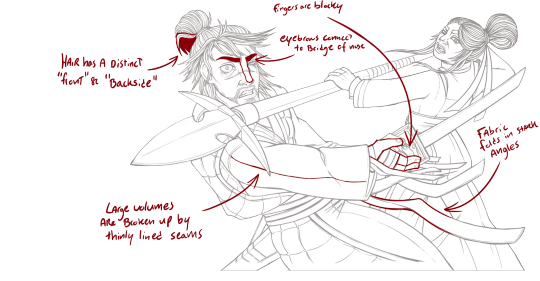
If you see people with highly developped styles, you’ll easily pick up on re-curring visual trends in their art. We call these recurring trends “trademarks”, and it’s these little stylistic details that can really top off a unique art-style with that extra bit of recognizeability.
Now, strip away all of the other footwork that is in their native style, the trademarks would not carry the whole visual identity on their own - so consider them a caketopper for your style-cake. A little sprinkle of razzle and dazzle.
You’ll most likely develop trademarks without knowing, but taking the time to really figure out where your trademarks are at, and develop them into polished features of your art can help set you apart from others, even those that are relatively close to your own style.Or..you could do like many of us other artists do - find out what you like about other peoples trademarks, and steal them for your own personal interpretation. My brow-connected noses are stolen directly from Dreamworks’ early 2D works. And my fingers is something i’ve lifted off a trend that went through the early 2000s gritty cartoons. The way my fabric acts are remnants of my time delving into the crime noir style, while the seams are of “my own” invention.
Your trademarks will probably end up like a pick and mix bag of the visual features you see in your inspirational sources, and that’s totally fine. Combining these traits will eventually add up to a cohesive and unique style that is wholly your own. Don’t let anyone convince you that artists don’t steal from each other all the time. It’s simply not true.
With all this in mind, you’re set to go on your way to start experimenting with your style, hopefully. Now there’s so much more specific things to delve into when it comes to crafting your art style ( see: toony vs realism spectrum, pallette preference, subject matter, individualized techniques, etc ) but these all file under “technical skill”, and i would be here all night if i was to talk to you about every single aspect of the craft that can affect your style. In truth that’s up to you to go out there and discover for yourself. Brave the vast wilderness of interesting and exciting styles, take from those what you need, and be experimentative, a little crazy, a little bold. It’s going to take a long time before you end up where you want to be. That’s just a matter of fact, so remember to have fun on your way there. And remember, your style is completely your own, and what you want to do with it - is completely up to you…
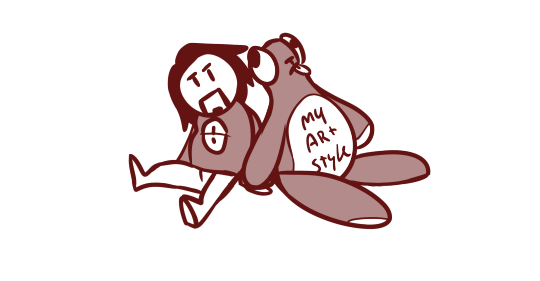
- Mod wackart ( ko-fi )
from The Redline Station https://ift.tt/2ZBTq7H
via IFTTT
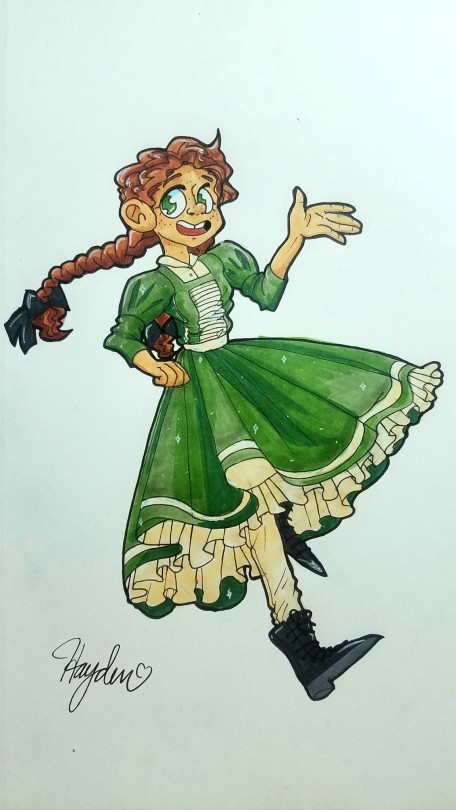
No comments:
Post a Comment